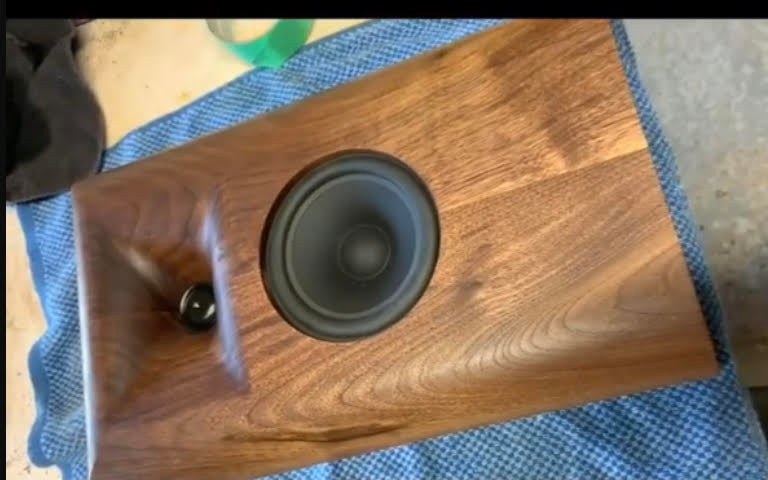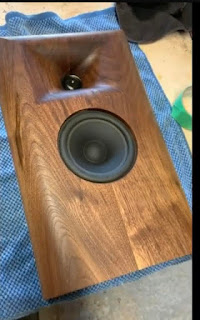Introduction
I normally focus on horn speakers however I've been wanting to develop a medium sized bookshelf speaker that uses technology from my flagship products. I still wanted the speaker to have a horn loaded tweeter and I also wanted it to use my ES horn flare curvature in both the horizontal and vertical axis. I also wanted the driver center spacing to still be as close as possible for the best integration at the crossover. So there is strong design rationale for this configuration since it provides the following benefits...
- By horn loading the tweeter I am able to control the off-axis coverage pattern so that it matches that of the woofer at the crossover point.
- The horn depth is 40mm which perfectly time aligns the tweeter to the woofer
- Distortion is reduced since the tweeter is not working as hard to produce the same output.
- The ES curvature will reduce edge diffraction off the speaker baffle edges.
|
Isomentric view of Speaker No.1159 featuring horn loaded tweeter |
Future Product
I will be offering this speaker as a commercial product with the following buying options...
- 3D CAD files for using in CNC or 3D printing (including crossover schematic)
- Purchase the baffle only in your choice of hardwood
- Purchase the baffle and cabinet as a flat pack.
- Purchase as a finished speaker (built to order)
Driver Selection
I wanted to use affordable drivers that are generally popular and well respected. These speakers are are developed to showcase the my own personal design ability to see what can be achieved with regular drivers.
Tweeter
I decided to use the popular SB Acoustics SB29RDNC dome tweeter. This tweeter currently retails for only $57.20 USD each.
|
SB Acoustics SB29RDNC Dome Tweeter |
Tweeter FeaturesAdvanced Features
- Non-resonant diaphragm design for minimum high frequency break-up
- CCAW voice coil for low moving mass
- Long life silver lead wires
- Low resonance frequency
- Copper cap on pole piece for reduced voice coil inductance and minimum phase shift
- Inherently shielded neodymium motor system
- Internal pressure equalization and flow resistor for non-resonant coupling of cavities
- Compact design
Woofer
The woofer is an SB Acoustics SB15NRXC30 5" woofer. I chose this woofer because it features a copper cap on the pole piece to reduce distortion.
|
SB Acoustics SB15NRX30 5" Woofer |
This woofer also has the following features...
- Non-resonant coated Papyrus fiber cone
- Low damping SBR surround
- Open structure cast frame for reduced reflections
- Copper cap on pole piece
- Raised spider
- 30mm Voice Coil diameter
- Frequency range 38Hz to 4kHz
- Gasket
Speaker No.1159 Design Details
Below is a sectioned cut-away of the horn in the horizontal plane. As you can see the ES flare geometry provides full wrap-around flare to the sides of the cabinet. This drastically reduces edge diffraction off the baffle edges.
|
Horizontal section view of the ES horn flare curvature |
The throat of the horn is sized so that half of the dome tweeter's surround is concealed. The rear of the baffle is pocketed out for the unusual shape of the existing tweeter bezel. This ensures that the throat of the horn is only 0.25mm away from the tweeter diaphragm. This is critical for ensuring there are no cancellation effects in the frequency response from sound escaping past the tweeter surround.
Below is a vertical section of the horn which is shorter in height. This allows for closer driver spacing with the woofer. This also controls vertical dispersion as well which limits floor and ceiling reflections.
|
Vertical section view of the ES horn flare curvature |
Relevant comparison
In order to showcase the benefits of 1159's horn I decided to make a regular speaker baffle using the same overall geometry and drivers except in a non-horn configuration.
|
Test baffle to used to compare acoustical measurement |
For reference the drawing below shows the physical dimensions of the comparison baffle.
|
Dimensions of test baffle |
After CNC machining the baffle I then stained the walnut with Watco danish oil. The appearance is very minimalistic and elegant.
|
1159 Solid walnut baffle with drivers mounted |
To compliment the overall aesthetic I developed a speaker stand. This stand is CNC cut from 24mm thick baltic birch plywood. The base of the speaker stand is 48mm thick.
|
Isometric view of 1159 with custom speaker stands |
Acoustical Measurements
Below is a raw frequency response comparison between the horn loaded 1159 baffle and the non-horn loaded test baffle. The mic was placed at 30cm distance from the front of the baffle. To protect the tweeter I used a 700Hz 48dB/LR high pass filter on my MiniDSP unit.
The horn is designed to have a low frequency cut-off of 2kHz (Fc). You can clearly see the horn's transfer function at work here by providing 6dB of gain at 2kHz and tapering off in a linear fashion up 2.5 octaves to 12kHz.
|
Frequency response comparison |
I then used my MiniDSP's parametric equalization function to see if I could impliment a very simple PEQ to flatten the response. The idea here is that if I can use a simple PEQ in DSP then there should be no issue implementing this in a passive crossover circuit.
|
Simple PEQ applied to flatten the frequency response of 1159 horn |
As you see in the above diagram is is relatively easy to flatten the response curve. The end result appears to be much flatter than the raw response of the non horn loaded test baffle.
I then conducted the following measurements with the woofer included in the test. I implemented a 2kHz 12dB/LR filter for 1159 and the test baffle. I've shown the resulting frequency response in the images below.
|
Using MiniDSP I used a 2kHz 12dB/LR filter for both tests |
Step Response
The system step response is compared below. The non-horn test baffle shows some misalignment in the time domain where the tweeter is a ahead of the woofer's impulse response. (see red arrows)
|
System step response compared |
Group Delay
The group delay also shows the advantage to the physical time alignment of the drivers. The non-horn loaded test baffle has the woofer trailing the tweeter by about 0.13 milliseconds which correlates to the 40mm distance that I've recessed the tweeter into the horn.
|
Group delay response comparison |
Burst Decay
Below is the burst decay comparison. The non-horn loaded test baffle has some minor resonances at 5kHz but otherwise the results are identical.
|
Bust decay comparison |
Off-Axis Frequency Response (Tweeter Only)
This is where things get interesting. As mentioned earlier the advantage of 1159's horn is that it provides controlled off-axis coverage.
Summary of test results...
Non-horn loaded test baffle
Coverage is 180 degrees up until 5.5kHz where it quickly norrows to 80 degrees at 10kHz. At 15kHz the coverage pattern has narrowed to only 60 degrees.
1159 Horn loaded baffle
The horn starts to provide pattern control at 1kHz where it gradually narrows to 120 degrees at 5kHz. This pattern width is maintained as constant directivity up to 9kHz where it narrows to 80 degrees at 15kHz.
Further observations...
Besides the well controlled off-axis coverage of the 1159 baffle, there is also 20 degrees wider coverage in the upper treble.
|
Tweeter only off-axis coloured polar map comparison |
Off-Axis Frequency Response (Woofer Only)
In an effort to establish a good system design its important to look at the off-axis polar pattern for the woofer as well. This will help us determine the most optimal crossover point.
Below is the horizontal off-axis coloured polar map for the woofer only. This measurement was done all the way out to 90 degrees off-axis to show where the woofer starts to become directional. As you can see the woofer starts to become directional at 1kHz and by 2kHz the woofer has a coverage pattern of 160 degrees.
|
Off-axis polar response of woofer ONLY |
The horn has perfect off-axis matching at 2kHz with the woofer. (see purple arrow below)
|
Matched polar response at 2kHz |
The same cannot be said for the non-horn loaded baffle. Notice how the off-axis of the tweeter is too hot even 80 degrees off axis at 2kHz. (see purple arrow below)
|
Non-matched polar with |
|
Non-matched polar zoomed in |
Off-Axis Frequency Response (System)
To highlight the effects of this I've conduct off-axis polar measurements of each system.
|
System (Tweeter and Woofer) polar response compared (out to 90 off-axis) |
To highlight the power response into the room even further I decided to continue my measurements out to 120 degrees off-axis. This means that the mic is now starting to go around to the rear of the speaker by 30 degrees off-axis.
|
Subjective Listening Impressions
The SB Acoustic drivers are excellent sounding drivers. The woofer provides very nice textured bass that is delicate and refined. The tweeter with the 1159 horn provides improved dynamics and overall clarity. Vocals are rendered with proper timbre and projects into the room with much more realism than the non-horn test baffle. I was surprised how much the sound degraded with the non-horn baffle, which at times sounded 'hashy' (is that a word?).
For inquiries please email me at Joseph_Crowe@josephcrowe.com


